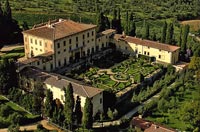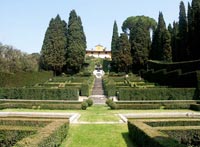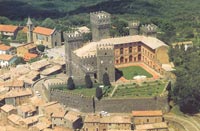Villa Bottini
|
| The Villa Buonvisi "al giardino", apart from being one of the most beautiful in the Lucchesia, played a very important part in Lucchese Architecture. Many villas were modelled on its composition plans and, in addition, it would seem that it was the model of the "ideal villa", outlined in Sanminiati treatise on the subject. The plan for the villa is rectangular and comprises a basement, a raised floor, a floor above of a substantially lower height, and a central elevation with a loggia. At the back of the building on the raised floor there is a portico which gives access to the hall. Wide openings, the play on symmetry and proportion among the architectural elements, give the villa a pleasant and harmonious lightness which is rarely found in other Lucchese villas. The vaults in the hall and those of the portico were frescoed by Ventura Salimbeni. The influence of Raffaello della Farnesina is visible in their realisation. These frescoes are the only remaining evidence of 16th century internal decoration among the Lucchese villas. Neoclassic decoration was added to the villa in the 1800's under the ownership of Princess Baciocchi. The entrance doors to the garden are noteworthy, in a bulky style decisively different from that of the building. The entrance door to the nymphaeum, the first example of serliana in the Lucchese villas, has an ingenious and original composition. The columns are made alternating between rough and smooth material and have two statues of rivers on top, which, in their disposition, simulate the shape of a divided tympanum. The villa was built in 1566 out with the surrounding medieval walls , in a zone cultivated with fruit and vegetables. Salimbeni's frescos found inside the villa, were started in 1593, and so the construction of the building must have been completed in that period. The authorship of the building's architecture and garden is much debated. Belli Barsali sustains that three architects worked on the villa: a non-identified architect for the building, Buontalenti on the entrance door to the nymphaeum, and Vincenzo Civitali on the entrance doors to the garden. Venturi had noted Ammannati's influence in the realisation of the front entrance and in the window of the surrounding wall. M. A. Giusti has attributed these works to Ammannati himself based on a design showing an example of a divided tympanum similar to the one in the villa. In addition, Guisti reputes that the realisation of the villa in its completeness is to be attributed to a collaboration between Ammannati and Vincenzo Civitali. |
Podere Santa Pia |
Podere Santa Pia, view from the garden on the valley below |
Villa Santini Torrigiani |
||
Villa Orlandini in Poggio Torselli |
Villa I Tatti, near Settignano, outside Florence |
Castello Torre Alfina |
||
|
||||
| The valley of the Serchio | From Lucca, after crossing Ponte a Moriano, thanks to the two roads that run parallel along the banks of the Serchio river, State Road 12 and the "Ludovica" Provincial road - named by Carlo Ludovico di Borbone, who had it realised so as to have a more rapid connection with Bagni alla Villa (today called Bagni di Lucca) - we penetrate into the Valley of the Serchio across verdant hills, deep gorges, arid vast plains broken up by ancient villages that maintain their charm intact. The first of these, Borgo a Mozzano, is located just before the Ponte della Maddalena, an incredible, magnificent medieval structure, the true symbol of the valley, known also as the Ponte del Diavolo because of the legend regarding its origins. The Castle of Mozzano was cited for the first time in documents in 1180, as the property of the Soffredinghi family, feudal lords. Conquered by Lucca in the following century, it progressively became one of the most important towns of the valley. The oldest portion of the village is divided around medieval palaces, several of which belonged to illustrious families such as the Castracana and Guinigi. The parish church of S. Jacopo has a imposing tower; in its interior, there is a baptismal font of 1590, various 16 th c. sacred furnishings, and groups by the Della Robbia school. Also worthy of note is the Convent of S. Francesco, with the lovely baroque church and elegant 16th-c. cloister. Manifestations of a certain importance, such as the April Azalea Biennial, an exhibit-market for flower nurseries, are held at Borgo a Mozzano; the Norwegian Codfish Festival is organised everv May I" in the hamlet of Anchiano, in collaboration with the Norwegian city of Aalesund. Once across the Serchio, along State Road 12, we reach Bagni di Lucca, an ancient little spa town, noted in documents ever since 1284 and located at the confluence of the Lima torrent with the Serchio river. Located at only 152 m a.s.l. among the mountains of the Tosco-Ernilian Apennines, this health resort is considered a genuine oasis because of its mild climate and the cordiality of its inhabitants. Bagni di Lucca knew a period of great magnificence during the 1911 century, when Carlo Ludovico di Borbone - an assiduous frequenter of the "bagni" attracted important people there. There were numerous presences from all over Europe: Byron, Shelley, Heine, Lamartine, Robert and Elisabeth B. Browning, Alexandre Dumas, Strauss, Liszt. Politicians kings and queens, and even Popes arrived there from Italy. Traces of this glorious period can be found in the monuments connected with the life of the baths, such as the Church, the English Cemetery, the Dernidoff hospital, the Ponte delle Catene, the work of Nottolini, which connected the territory in the north of the Commune with that of Borgo a Mozzano, the Casino, where people played roulette for the first time in Europe; and the Foreigners' Club. Magnificent churches and Romanesque parish churches abound in the nearby villages of Benabbio, S. Pietro a Corsena, Vicopancellorum, Casabasciana, S. Cassiano di Controne, and Montefegatesi. Behind Bagni di Lucca and beyond Montefegatesi looms Orrido di Botri, the sheer walls of which form a profound canyon crossed by the Marianna torrent. From Orrido, we descend again towards Coreglia Antelminelli. An ancient feud of the Rolandinghi family, lords of the southern Garfagnana, it was transformed into a stronghold by the Antelminelli family of Ghivizzano. The central nucleus of Coreglia still partially pre serves the appearance of a medieval fortress. The two Romanesque churches of S. Martino (9th c.) and S. Michele (12"' c.), the imposing bell tower (11th c.), and the Fort arc of a certain value. Coreglia deserves a visit even if only to see the very unusual Museum of Plaster of Paris Figurines and Emigration, housed in beautiful Palazzo Vanni, which exhibits the history and activity of the figurine makers: emigrant-artisans of these climes have handed down the art of plaster of Paris from father to son, to our day. Busts of Greek and Roman philosophers, kings, emperors, mythological personages, and the great celebrities of music, art and literature; reproductions of animals: there are thousands of examples on exhibit in the Museum. The usage of working plaster of Paris originated at Coreglia Antelminelli between the 16'" and 17'" centuries. Since then, this activity has assumed morc and more importance, to the point of becoming the main occupation of the local population. There thus began this phenomenon of mass emigration that was inseparably linked to the production and peddling of these figurines that occurred only within the limited geographical area of the valley of the Serchio and of the Val di Lima. Returning along Regionale, in a very short time we reach Barga. Located at the centre of the valley of the Serchio, Barga still has the appearance of a very lovely medieval village with narrow winding streets. The steep Via del Pretorio leads to the Cathedral, which is dedicated to Saints Jacopo and Cristoforo. The primitive construction is previous to the year 1000; Romanesque is evident in the capitals and in the architraves sculpted in a single block of stone and abounding in medieval symbols. Above the side door is the most famous frieze, called Agape, which is attributed to Biduino. inside, there are the very fine sculptures of the pulpit, rich in marble inlays, attributed to Guido Bigarelli, a sculptor frorn Como (ca. 13"' c.). Noteworthy are the Della Robbian terra-cottas that decorate the Chapel of the Sacrament. In the vicinity of Barga, at Castelvecchio Pascoli, there is the house where Giovanni Pascoli lived from 1895 to 1912. The poet chose this place because of the beauty of the landscape. He is buried here, in the chapel adjacent to the villa. In the house there is a collection of manuscripts, diplomas, and books that belonged to the poet. Every September, the Pascoli Readings, which are then published in the "Quaderni Pascoliani", are held in Barga. To be noted are its numerous cultural and folklore manifestations, among which the charming Living Creche, realised in December in the town's historic centre. The last Commune of the Media Valle is Fabbriche di Vallico, situated on the opposite part of the Serchio with respect to Barga, in the Nature Park of the Apuan Alps, in the midst of woods and chestnuts groves, close to a large artificial lake. The history of this village is linked to the transfer from Bergamo of a numerous colony of blacksmiths, who settled in the area around the 14th c. Among the buildings we can recall the Church of S. Jacopo and, at Vallico Sotto, the architectural complex that leads to Piazza della Chiesa, with its stupendous triptych of the Madonna con Bambino e Santi; while at Vallico Sopra, there is the Romanesque church of S. Michele. |
||||







